Lower Urinary Tract Infection : Case Study Report
25 Pages6970 Words647 Views
Added on 2020-05-28
Lower Urinary Tract Infection : Case Study Report
Added on 2020-05-28
ShareRelated Documents
Running head: LOWER URINARY TRACT INFECTIONLOWER URINARY TRACT INFECTIONName of the StudentName of the UniversityAuthor Notes

LOWER URINARY TRACT INFECTION1Executive SummaryThis report is the case study of Queenie Jacobs, who had been admitted to the hospital withsymptoms of confusion, dehydration and fever. Further examination revealed that she wassuffering from lower urinary tract infection. The causative organism was Escherichia coli and itwas found to be sensitive to co-amoxiclav. Because of her dehydration she was treated withintravenous fluids and Trimethoprim initially, then given oral administrations of co-amoxiclav.This report provides the pathophysiology of the disease along with the symptoms, risk factors,complications and the necessary nursing care plan. The report also provides the pharmacology ofthe medication along with medication management standards.
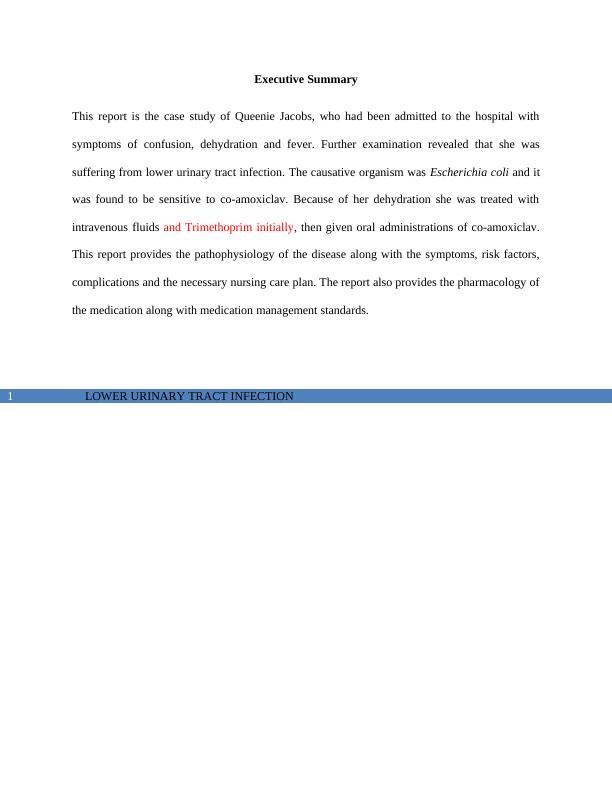
LOWER URINARY TRACT INFECTION2Table of ContentsLower urinary tract infection...........................................................................................................4Pathophysiology of lower urinary tract infection............................................................................5Signs and symptoms........................................................................................................................6Association of E. coli with urinary tract infections.........................................................................6Complications of urinary tract infections........................................................................................8Nursing care for urinary tract infections..........................................................................................8Pharmacodynamic and pharmacokinetic principles of Co-amoxiclav..........................................10Side effects of the drug..................................................................................................................13Antibiotic Resistance.....................................................................................................................14Medication management................................................................................................................14Conclusion.....................................................................................................................................15Reference List................................................................................................................................17
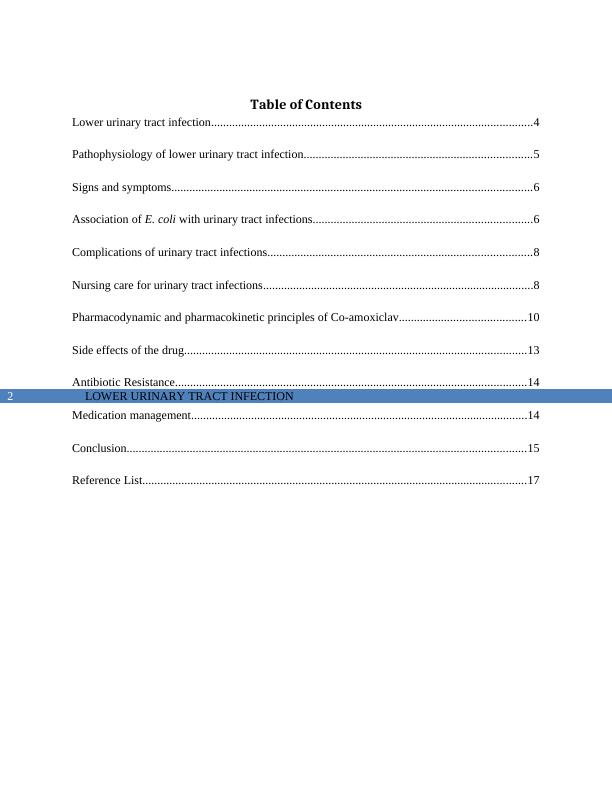
LOWER URINARY TRACT INFECTION3IntroductionLower urinary tract infections are found to be common among women, particularly thepost-menopausal women (Al-Badr and Al-Shaikh 2013). This is the most common form ofbacterial infection that occur among women (Hotchandani and Aggarwal 2012). Lower urinarytract infections among women can be classified based on the age of the women (Tan andChlebicki 2016). These include the pre-menopausal women, healthy post-menopausal women ofthe age group between 50-70 years old and the institutionalized post-menopausal elderly women(Mody and Juthani-Mehta 2014). Most of the elderly women with lower urinary tract infectionsremain asymptomatic, however, some suffer from symptoms like incontinence, frequenturination, discomfort during urine discharge (Komala and Kumar 2013). Post-menopausalwomen are particularly prone to this problem. This can be due to the fact that the levels of thehormone estrogen declines under such conditions, which predisposes them to contracting suchinfections (Robinson, Toozs-Hobson and Cardozo 2013).This report is based on the case study of Queenie Jacobs, who is a 73-year-old women.She got admitted to the hospital after showings signs of dehydration, confusion and fever.According to her husband, she had been showing signs of frequent urination and a burningsensation during urine discharge. Dipstick analysis was done to determine the presence ofleukocyte esterase and nitrate (Mambatta et al. 2015). Mid-stream urinalysis report revealed thatshe was positive for leukocyte esterase and nitrate. Further microscopy, culture and sensitivitytests revealed the presence of Escherichia coli infection, which is sensitive to co-amoxiclav.Management of urinary tract infections is complicated due to the presence of antibioticresistance. Trimethoprim and sulfamethoxazole are the 2 antibiotics, which are prescribed forurinary tract infections. However, E. coli strains have been found that are resistant to these
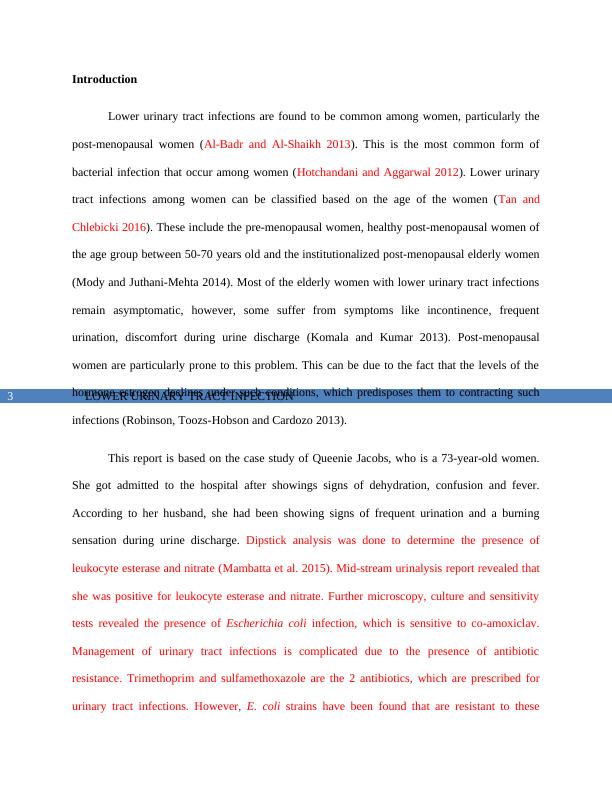
LOWER URINARY TRACT INFECTION4antibiotics (Guneysel, Suman and Cimilli Ozturk 2016). In this case study, the resultant E. colistrain being Trimethoprim resistant was administered with co-amoxiclav. This report will provide a brief description of the lower urinary tract infections, riskfactors of the patient in the case study, pathophysiology of the infection; role of E. coli in theinfection occurrence, signs and symptoms of the disease, complications associated with theinfection, the necessary nursing care and pharmacological description of the administeredmedication. Lower urinary tract infectionUrinary tract infections are localized to the urinary tract. Lower urinary tract infectionsare also called cystitis (Barber et al. 2013). The lower urinary tract infections can be eithersymptomatic or asymptomatic. Presence of bacteria in the urine but without the presence ofsymptoms are termed as asymptomatic bacteriuria (Cai et al. 2012). Symptomatic infections areassociated with frequent urination, problems during urine discharge and incontinence (Mody andJuthani-Mehta 2014). Lower urinary tract infections are common among pre as well as post-menopausal women. E. coli is the most common cause of lower urinary tract infections (Flores-Mireles et al. 2015). There are various causes that can give rise to lower urinary tract infectionsamong both men and women. Sexually active and post-menopausal women are highly prone tocontracting urinary tract infections (Cai et al. 2012). Among men, presence of chronic prostatitiscan give rise to lower urinary tract infection (Zhao et al. 2012). Urinary catheterization is alsoanother risk factor that pre-disposes an individual to lower urinary tract infections. Moreover,diabetes can also predispose an individual to developing lower urinary tract infections. Inchildren, constipation and vesicoureteral reflux is associated with the development of lower
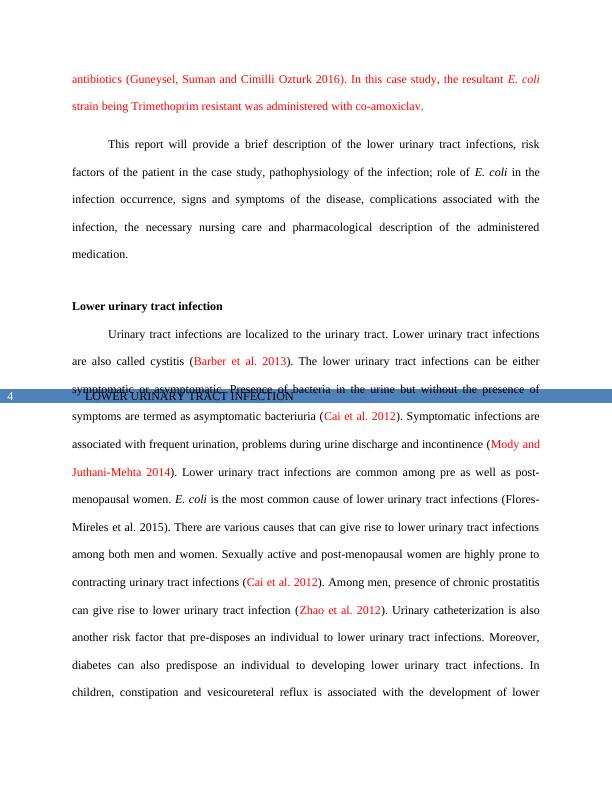
LOWER URINARY TRACT INFECTION5urinary tract infections (Foxman 2014). The patient described in this case study is a 73-year oldfemale. She is healthy but is post-menopausal. So, her lower urinary tract infection falls underthe classification involving healthy post-menopausal women, who are not hospitalized or usecatheters. Estrogen deficiency plays an important role in the development of lower urinary tractinfections among post-menopausal women (Kim et al. 2015). Reduction in estrogen levels isassociated with vaginal atrophy. It is associated with symptoms like vaginal dryness,dyspareyunia, itching and incontinence. Estrogen also helps to maintain the normal vaginal florathat maintains the acidic pH and prevents colonization of pathogens that cause urinary tractinfections (Goldstein et al. 2013). Thus, in this case study, the patient being post-menopausalhave resulted in her developing the urinary tract infection. Pathophysiology of lower urinary tract infectionUrinary tract infections can be symptomatic and asymptomatic. Symptomatic bactertialinfections involve infections of the lower urinary tract also called cystitis and infection of theupper urinary tract also called acute pyelonephritis. Asymptomatic urinary tract infections resultswhen urine cultures have greater than 100,000 colony forming units per ml of urine with absenceof symptoms (Fünfstück et al. 2012). Urinary tract infections are considered to be complicatedwhen there are presence of symptoms of pyelonephritis. Moreover, urinary tract infections areconsidered to be complicated if found in immunosuppressed individuals, diabetics, pregnantwomen, men or individuals with urinary tract structural abnormalities (Mnif et al. 2013; Hooton2012). E. coli is most commonly associated with these infections. The first step in thedevelopment of the infection by the pathogen is periurethral colonization. This is followed byattachment and subsequent penetration of the bladder epithelium. Penetration is followed bybacterial replication and the formation of biofilms. Bacterilal colonization is followed by
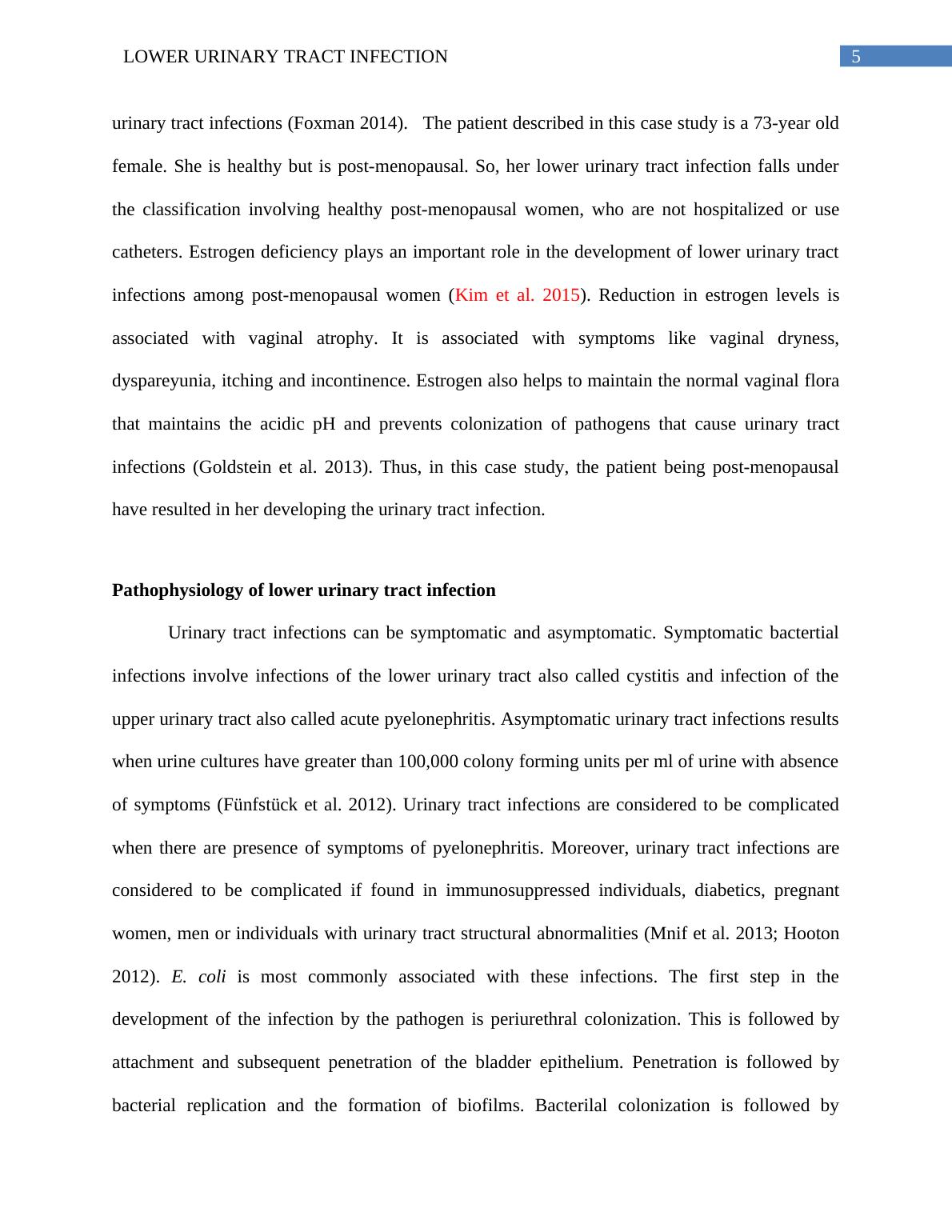
End of preview
Want to access all the pages? Upload your documents or become a member.
Related Documents
Urinary Tract Infection Risk Factorslg...
|4
|729
|25
Evaluation of long term antibiotic therapy for UTIs: a systematic reviewlg...
|9
|3284
|279
Urinary Tract Infection: Causes, Symptoms, and Managementlg...
|13
|1736
|1
Clinical Guidelines on Urinary Tract Infectionlg...
|13
|2690
|74
Nursing Assignment: UTI, Lymphoedema, Diabetes, and Nursing Care Planslg...
|7
|1125
|362
